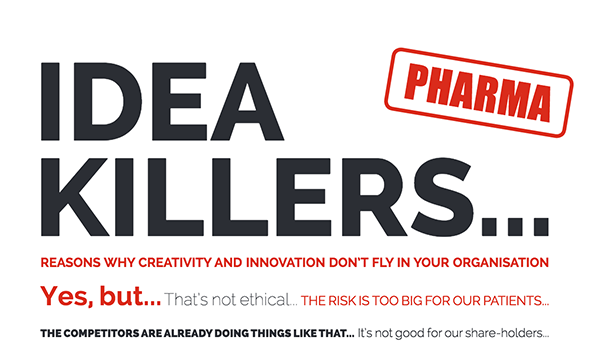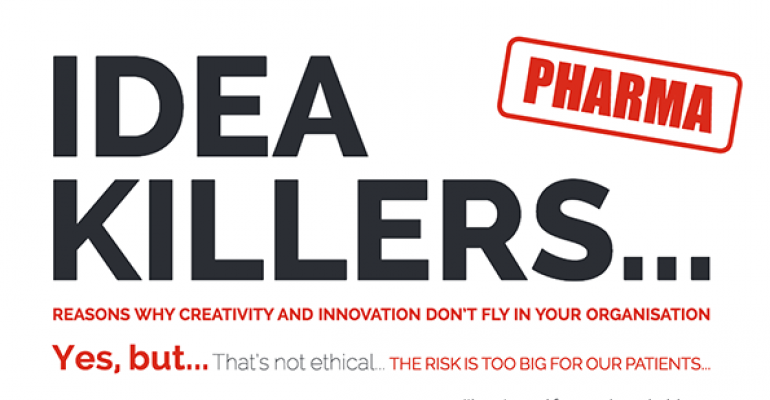Today's guest post is by speaker and author Cyriel Kortleven, CSP
“Yes but” ... “No money” ... “No time” ... these are classic idea killers meeting planners hear when they try something new to improve their events. And for those who design events for pharmaceutical companies, these idea-killing phrases multiply exponentially.
I've been in touch with more than 20 pharmaceutical professionals to find out which they hear most often—think “Compliance won’t allow this” and “It’s not possible with the current legislation,” for starters. You can download a PDF poster with the pharma idea killers I collected here. Go ahead and print it out and put it up in your conference room.
And then kill those idea killers. Here are two exercises that can help.
1. Apply the three-minute rule.
 While 90 percent of the items on your agenda likely can be handled readily enough, chances are that there's one item that could use some creativity. Maybe you want to attract a different target group, or there's a challenge that couldn't be solved in a logical way, or you just want to try something special.
While 90 percent of the items on your agenda likely can be handled readily enough, chances are that there's one item that could use some creativity. Maybe you want to attract a different target group, or there's a challenge that couldn't be solved in a logical way, or you just want to try something special.
Start by explaining why, even though it’s difficult, everyone needs to suspend judgment of new ideas. One way to do that is to ask them to apply the “Yes and” mindset—for the next three minutes, instead of responding with an ideakiller, they have to answer with “Yes and,” accepting the idea and adding to it.
During those three minutes, there is no judgment, and the ideas should flow freely—quantity is more important than quality. Some of those ideas will probably be a little crazy, but that’s OK because you’re just exploring the possibilities. After the three minutes are up, pick through all the ideas that were generated. Maybe you can use some of the more feasible elements of an idea, or combine several small ideas into one or two good solutions. An extra advantage is that everyone has an opportunity to contribute, so the chance that the idea will be implemented also grows substantially.
2. Use the five glasses method to break fixed thinking patterns.
 You can do this on your own or with a colleague. Write your challenge or problem at the top of a piece of paper, then write down two or three ideas about how you could solve that challenge.
You can do this on your own or with a colleague. Write your challenge or problem at the top of a piece of paper, then write down two or three ideas about how you could solve that challenge.
Next, imagine you are one of your colleagues—how would that person solve the same challenge? Write down what you envision their top two or three solutions would be.
Then imagine that you were working in a different department of your company. Instead of being an event manager, you are now working in marketing or HR or finance. Generate two or three new ideas that you think they would have to solve a similar challenge.
For the next round, put yourself in a competitor’s shoes and write down a few ideas about how you think they would tackle the challenge.
Round 4: Imagine that you're not working in the pharma industry anymore; now you work in automotive or in government, or you're an employee in an amusement park—how would that person cope with a similar challenge?
And finally, take on the perspective of a totally random person—your neighbor, a good friend, the president of the U.S.—and come up with two or three more ideas.
Try to finish this exercise in a maximum of six minutes, giving a minute or so to each perspective. When you’re finished, scan the list of 12 to 18 ideas to see if there's one idea (or a part of an idea) that might be interesting to explore.
I'm quite sure you will find an idea or two that jump out—those could be the start of a real breakthrough idea to solve your challenge. Mission completed.
The Benefits of Postponing Judgment
Postponing judgment can lead to some interesting innovations. Need some inspiration? Here are a few examples:
• Breakthrough genomic cancer testing from a single blood draw. Guardian Health has helped thousands of oncologists learn accurate and actionable information about tens of thousands of patients, while avoiding the costs and risks of tissue biopsies. The company’s genomic test helps match patients to approved targeted therapies as well as drugs in clinical trials. (via GuardianHealth.com)
• Personal microbe bank for healthy gut bacteria. Open Biome works with clinicians to make fecal microbiota transplantation (FMT) easier, cheaper, safer, and more widely available by providing hospitals with screened, frozen material ready for clinical use. This service is designed to eliminate the time, staff, protocols, and facilities needed to screen and prepare material from new donors for each treatment.
• Headphones that release happiness chemicals. Nervana is a consumer product that synchronizes nerve stimulation with sound, allowing the user to experience qualities of music never felt before.
• MotoRepellent is a lightweight, mobile device filled with non-toxic mosquito repelling oil that magnetically attaches to the end of a motorcycle’s exhaust pipe. Heat from the exhaust activates the oil and mosquito-repelling scent is propelled out into the air via exhaust pressure. As the main mode of transportation in the slums, motorcycles easily navigate the narrow alleys and reach every corner. As the motorcycles pass by, mosquitos within a radius of up to three meters are repelled, giving residents a safer, mosquito-free environment.
 Professional speaker Cyriel Kortleven, CSP, creates an open and informal atmosphere—ideal for bigger events and conferences. He stimulates people to break their fixed-thinking patterns and inspires with creative skills and examples of how you can gain more with less.
Professional speaker Cyriel Kortleven, CSP, creates an open and informal atmosphere—ideal for bigger events and conferences. He stimulates people to break their fixed-thinking patterns and inspires with creative skills and examples of how you can gain more with less.
Cyriel has worked more then 15 years in the domain of creativity and innovation. He delivers keynotes all over the world and has authored four books. Via his website, you can subscribe to his weekly blog and get a nine-week inspiration boost.





